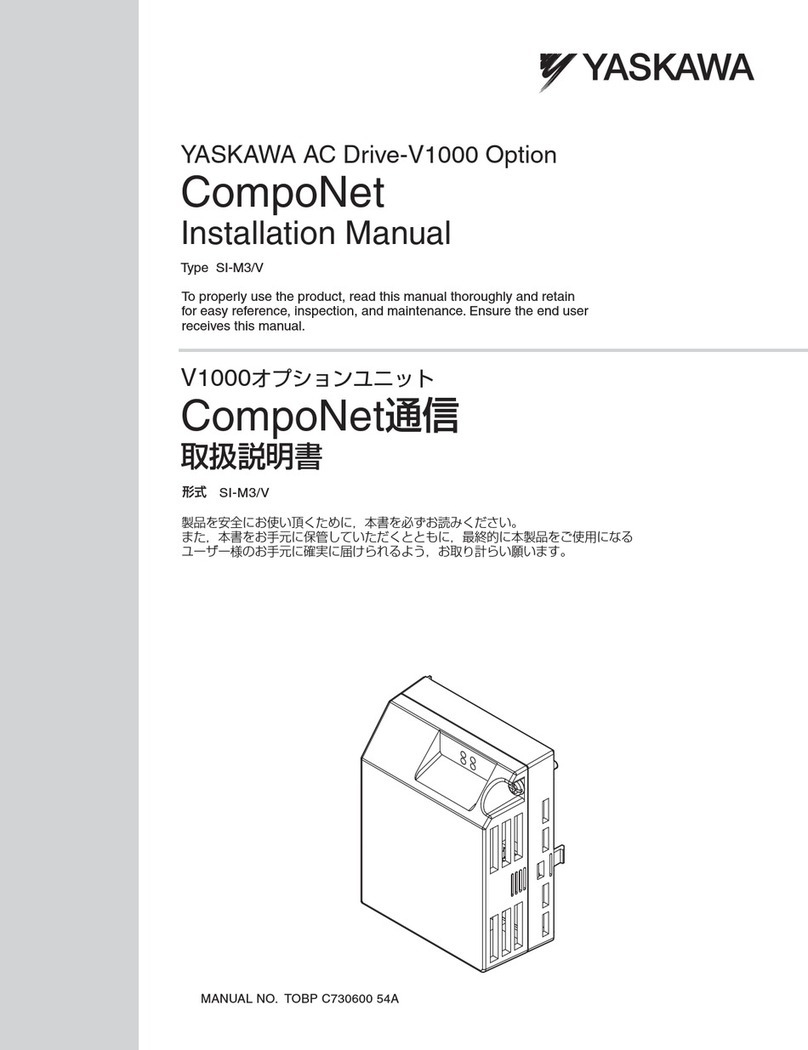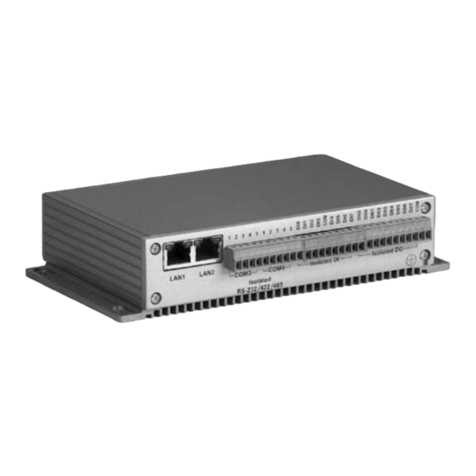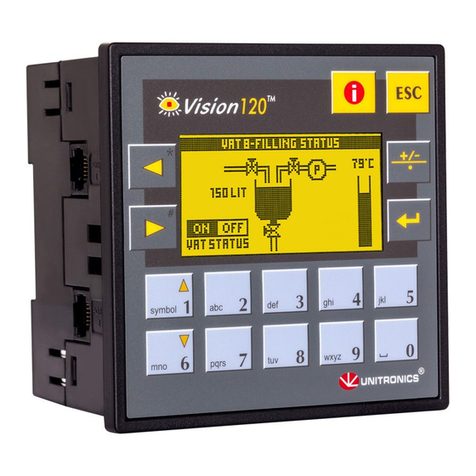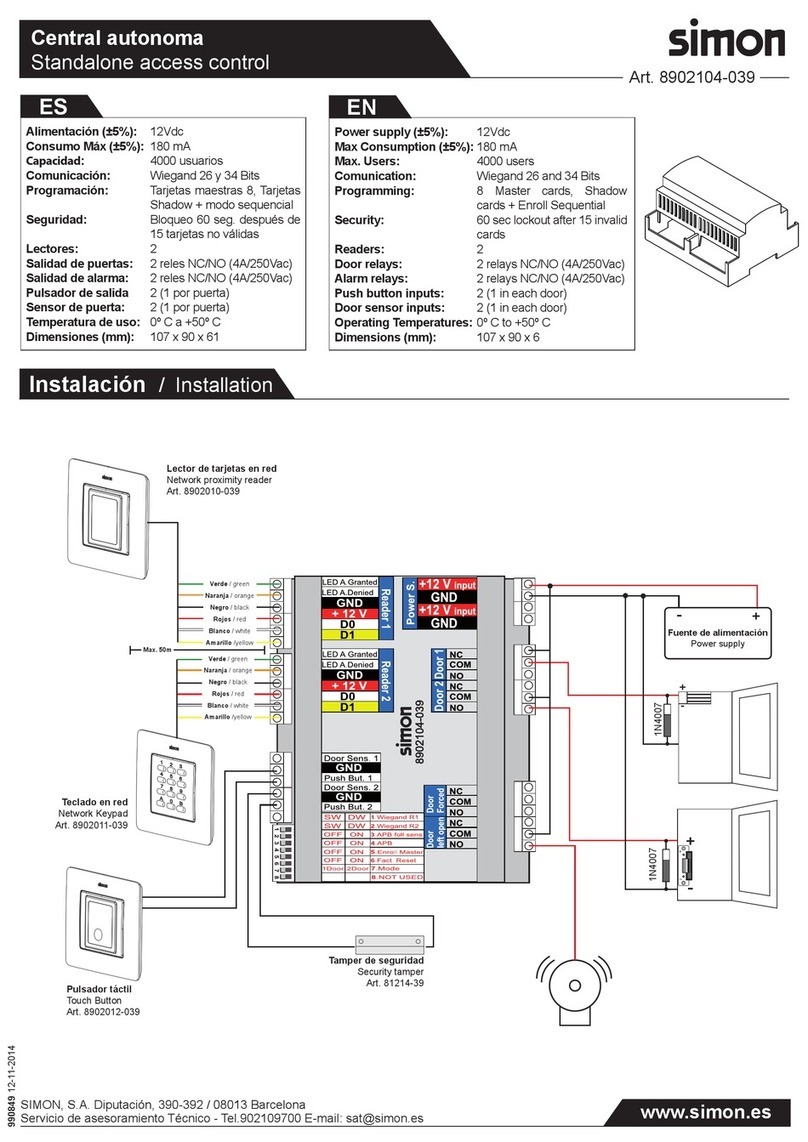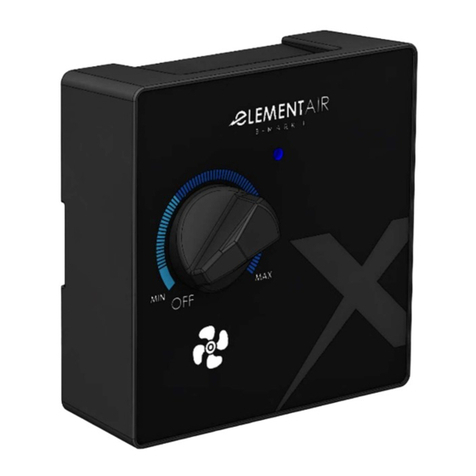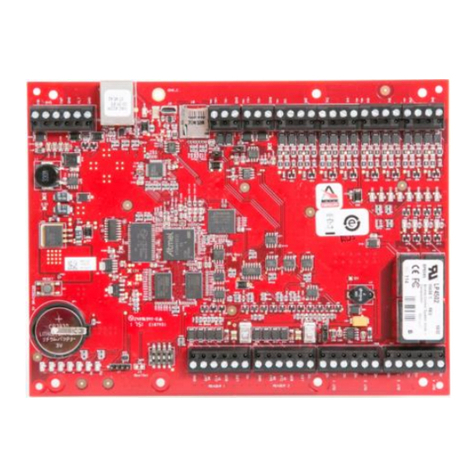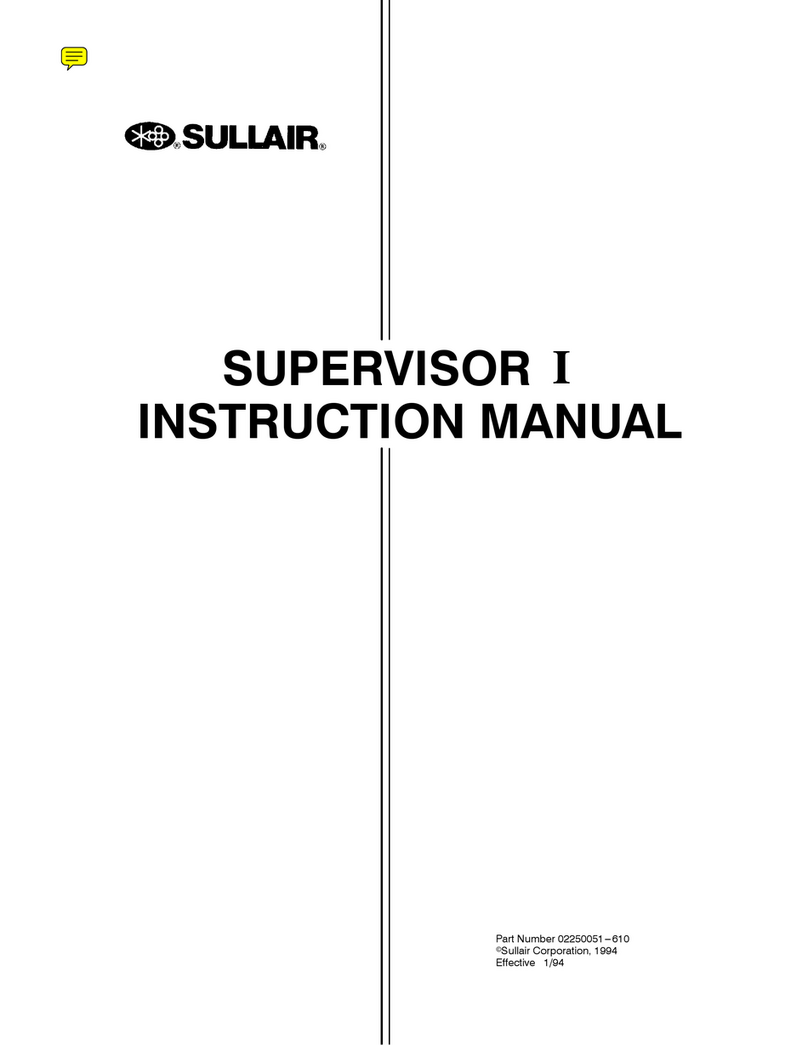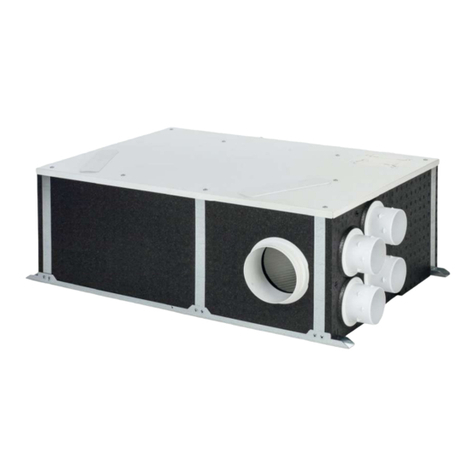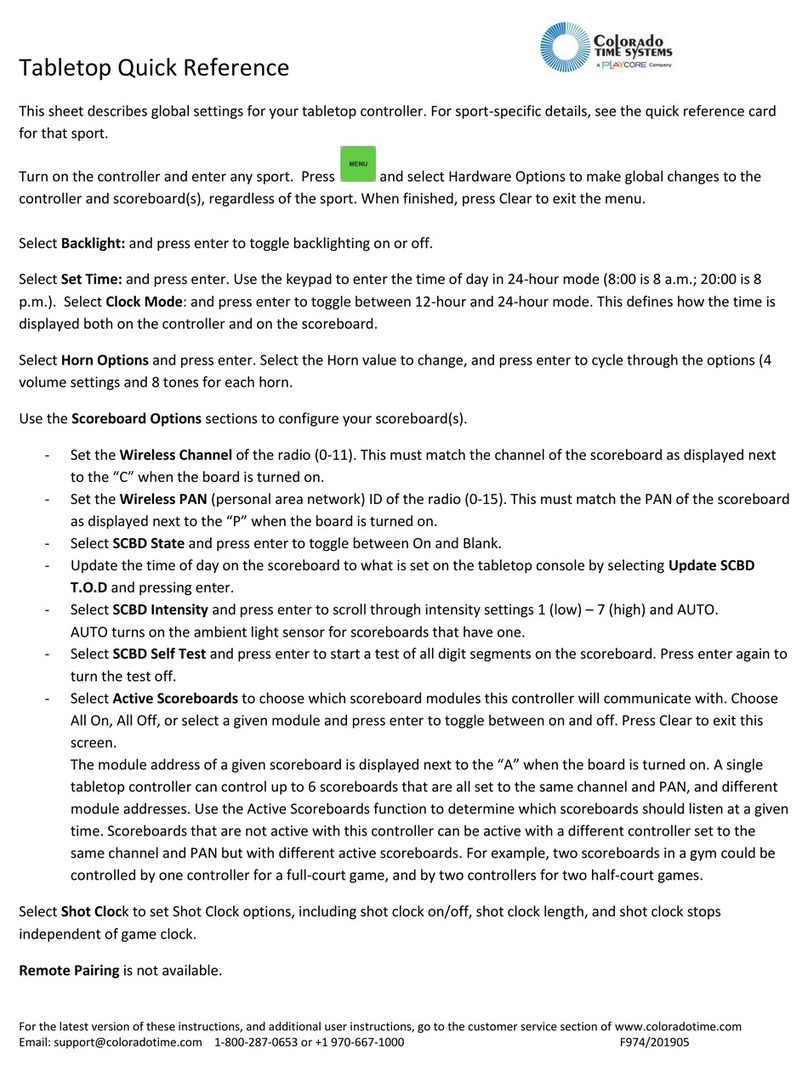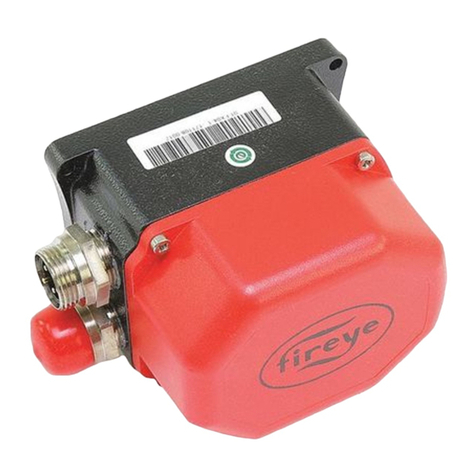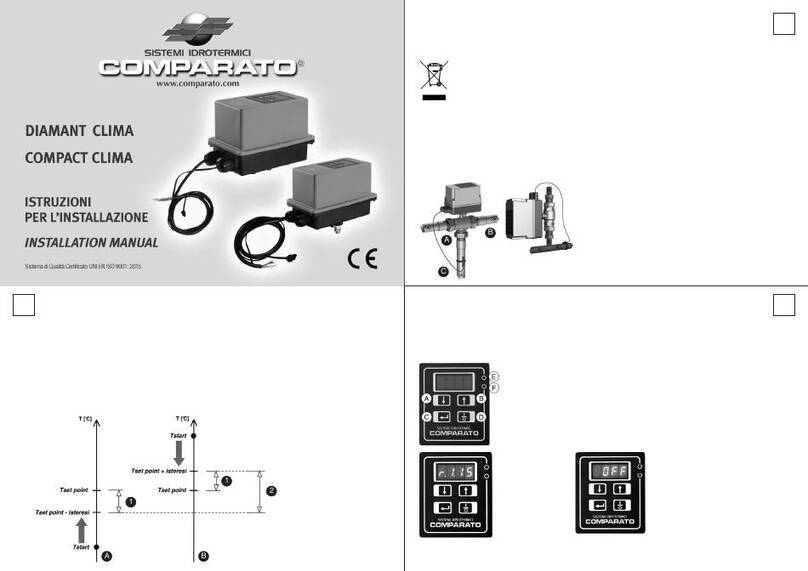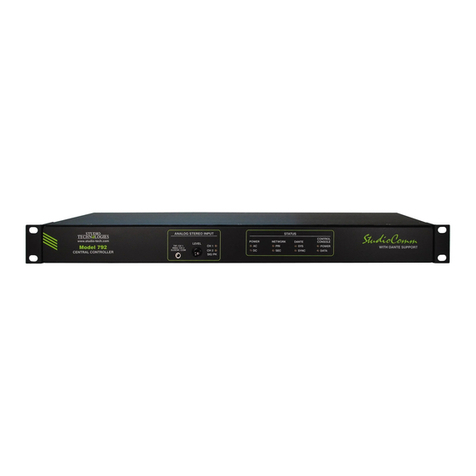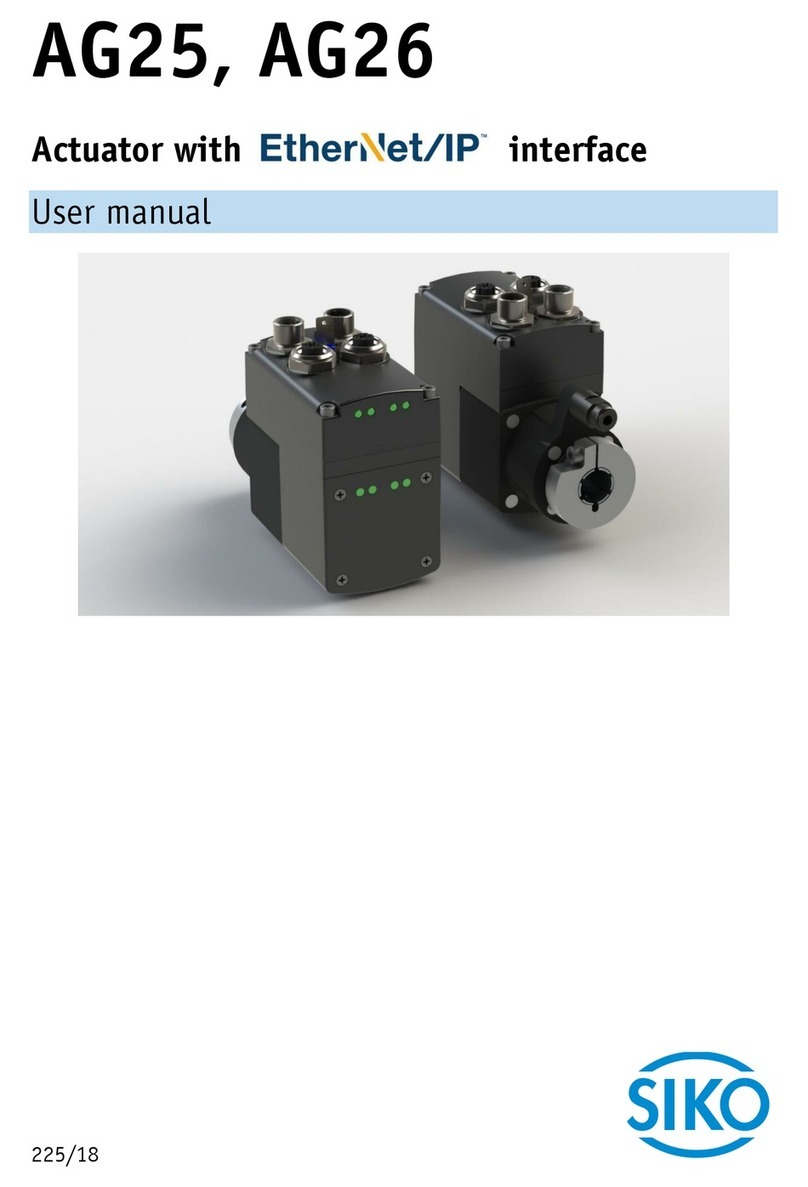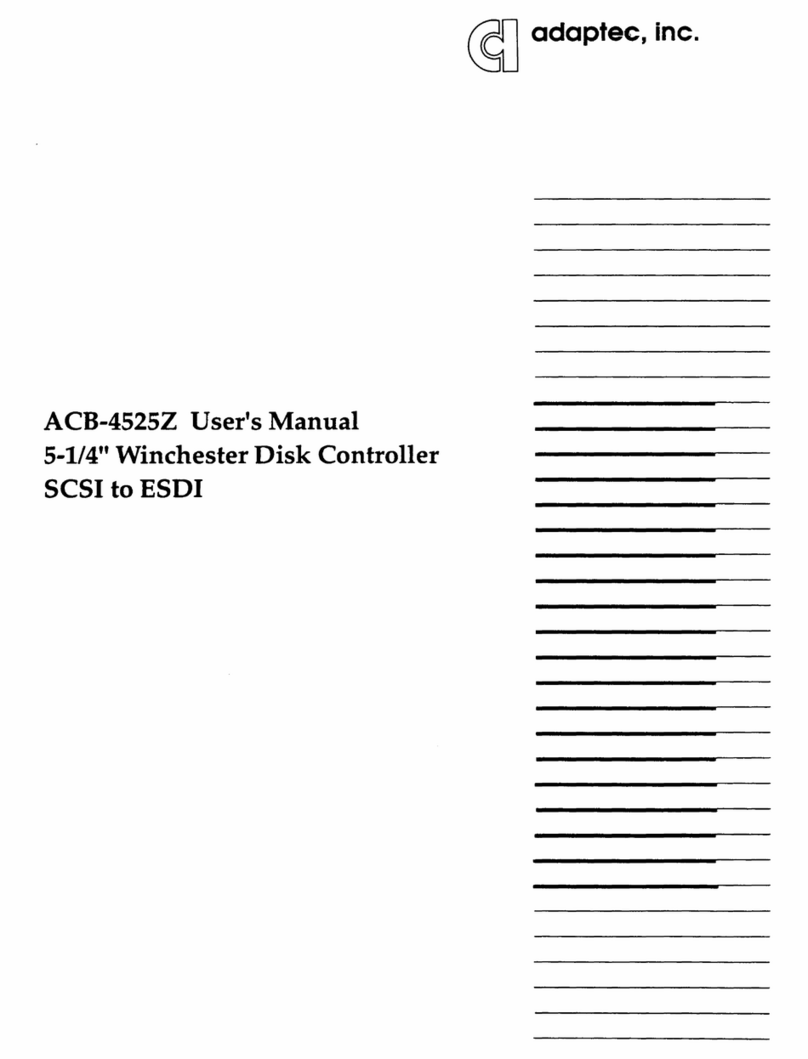HeatLink 31360 User manual

The
SystemHeatFloor
®
LinkHeat
Mixing Valve Reset Control
Stk# 31360
VIEW ADJUST
TARGET
INDR
DSGN DIFF
BOIL
MIX
OUTDR
ROOM WWSD
˚
F
˚
C
MAXMIN
OCC
UN
C US
158033
Made in Canada by
Power:
Floating Output:
Relays:
Demand:
120 V + 10% 50/60 Hz 1300 VA
24 V (ac) 0.34 A 8 VA
240 V (ac) 10 A 1/3 hp, pilot duty 240 VA
20 to 260 V (ac) 2 VA
Signal wiring must be
rated at least 300 V.
Test
Terminal
Unit
Boiler
9 10
R
Opn R
Cls
11
C
Powered Output
78
LNSys
Pmp N
1
Mixing
Demand
23456
Power
12 13 14 15 16 17
Do not apply power
UnO
Sw Com Boil Mix Com Out
Item
Motor
Speed Open Close Mixing
Demand
Input
Timer
Optional
Output
Mixing Valve &
Actuating Motor
M
Boiler
Output
Boiler
Input
Universal Sensor
(included)
Mixing Valve Reset Control 31360
Floating Action
®
LinkHeat
Input
120 V (ac)
Power
Supply
Input
Mix Demand
signal
Output
Mixing System
Pump
Input
Indoor Sensor
Optional
(European version only)
Input
Outdoor Sensor
(included)
Input
Universal Sensor
(included)
L631360
May 16, 2008
North American version shown

HeatLink®Mixing Valve Reset Control Stk# 31360
®
LinkHeat
www.heatlinkgroup.com
HeatLink
2
Introduction
Table of Contents:
Table of Contents / Introduction..................................................................................................................... Pg. 2
User Interface ................................................................................................................................................. Pg. 3-4
General Operation .......................................................................................................................................... Pg. 4-5
Mixing Operation (North American version)................................................................................................. Pg. 6-7
Mixing Operation (European version) ........................................................................................................... Pg. 8-10
Boiler Operation (North American version)................................................................................................... Pg. 11
Boiler Operation (European version) ............................................................................................................. Pg. 12
Installation
Step 1 - Materials .................................................................................................................................... Pg. 13
Step Two - Mounting the Base................................................................................................................ Pg. 13
Step Three - Rough-in Wiring................................................................................................................. Pg. 13
Step Four - Electrical Connections to the Control .................................................................................. Pg. 13-15
Step Five - Testing the Wiring................................................................................................................. Pg. 15-16
Quick Setup .................................................................................................................................................... Pg. 17-18
View Menu ..................................................................................................................................................... Pg. 19
Adjust Menu .................................................................................................................................................. Pg. 20-21
Testing & Troubleshooting............................................................................................................................. Pg. 21-22
Error Messages............................................................................................................................................... Pg. 23
Technical & Electrical Information
TECH 5.1: 1 Circuit (Fully Modulating Floor Heating) ....................................................................... Pg. 24
ELECT 5.1: 1 Circuit (Fully Modulating Floor Heating) .................................................................... Pg. 25
TECH 5.2: 2 Circuit (Fully Modulating Fl. Ht. plus indirect Fired Storage Tank)................................. Pg. 26
ELECT 5.2: Indoor/Outdoor controller c/w Optional Standard Thermostats......................................... Pg. 27
TECH 5.3: 3 Circuit (Modulating Floor Heating plus High Temp. Circuits) ......................................... Pg. 28
ELECT 5.3: StatLink®Controls Activating Low & High Temp. Circuits .............................................. Pg. 30-31
TECH 5.4: 6 Circuit (Mod. Fl. Ht. & SnowMelt plus Additional Htg. Components) ............................ Pg. 32
ELECT 5.4: StatLink®Controls Activating Circuits plus SnowMelt. Controller................................... Pg. 34-35
TECH 5.5: 4 Circuit (Mod. Fl. Ht. plus Fan Coil, IFHWH & Secondary Ht. Exchanger)..................... Pg. 36
ELECT 5.5: StatLink®Activating Low Temp. plus Independent High Temp. Circuits.......................... Pg. 38-39
TECH 5.6: Multiple Low Temperature Circuits ..................................................................................... Pg. 40
ELECT 5.6: Indoor/Outdoor Controller c/w Multiple Standard Room Thermostats ............................. Pg. 41
Technical Data................................................................................................................................................ Pg. 44
Warranty ......................................................................................................................................................... Pg. 44
The HeatLink®Mixing Valve Reset Control Stk# 31360 is designed to control the supply water temperature to a hydronic system in order to provide
outdoor reset or setpoint operation. The control uses a floating action mixing valve to regulate the supply water temperature, while protecting the
boiler against flue gas condensation. The control has a Liquid Crystal Display (LCD) to view system status and operating information.
Additional functions include:
• User comfort adjustment to increase or decrease building space temperature
• Powered mixing system pump output
• Test sequence to ensure proper component operation
• Setback input for energy savings
• North American version
• 120 V (ac) power supply
• CSA C US certied (approved to applicable UL standards)
• European version
• 230 V (ac) power supply
• Advanced settings to ne-tune building requirements
• Boiler Control for improved energy savings
• Quick Setup for easy installation and programming of control
• Optional indoor sensor for room air temperature control
• CE approved
Introduction

HeatLink®Mixing Valve Reset Control Stk# 31360
HeatLink
®
LinkHeat
3
www.heatlinkgroup.com
User Interface
The HeatLink®Mixing Valve Reset Control Stk# 31360 uses a Liquid Crystal Display (LCD) as the method of supplying information. You use
the LCD in order to set up and monitor the operation of your system. The Stk# 31360 has three push buttons (Item, “Up”, “Down”) for selecting,
viewing, and adjusting settings. As you program your control, record your settings in the ADJUST menu table which is found in the second half
of this brochure.
Item
• The abbreviated name of the selected item will be displayed in the item eld of the display. To view the next
available item, press and release the Item button. Once you have reached the last available item, pressing and
releasing the Item button will return the display to the rst item.
Item
Adjust
• To make an adjustment to a setting in the control, press and hold simultaneously for 1 second, the Item, “Up”
and “Down” buttons. The display will then show the word ADJUST in the top right corner. Then select the
desired item using the Item button. Finally, use the “Up” and / or “Down” button to make the adjustment.
• To exit the ADJUST menu, either select the ESC item and press the “Up” or “Down” button, or leave the
adjustment buttons alone for 20 seconds.
• When the Item button is pressed and held in the VIEW menu, the display scrolls through all the adjust items in both access levels.
• Additional information can be gained by observing the status eld and pointers of the LCD. The status eld will indicate which of the control’s
outputs are currently active. Most symbols in the status eld are only visible when the VIEW menu is selected.
Item
Number Field
Displays the current value
of the selected item
Menu Field
Displays the
current menu
Buttons
Selects Menus, Items and
adjusts settings
Item
{
Terminal Unit
VIEW ADJUST
TARGET
INDR
DSGN DIFF
BOIL
MIX
OUTDR
ROOM WWSD
˚
F
˚
C
MAXMIN
OCC
UN
Motor Speed Open Close Mixing Demand
Item Field
Displays an abbreviated
name of the selected item
Status Field
Displays the current status of
the control’s inputs, outputs and
operation
User Interface
North American & European Versions

HeatLink®Mixing Valve Reset Control Stk# 31360
®
LinkHeat
www.heatlinkgroup.com
HeatLink
4
Symbol Description
User Interface / General Operation
General Operation
Pump
Displays when the mixing system pump is in
operation.
Burner
Displays when the boiler relay is turned on.
Occupied Schedule
Displays when the control is in occupied (Day)
mode.
Unoccupied Schedule
Displays when the control is in unoccupied (Night)
mode.
UNOCC
°F, °C
Displays the unit of measure that all of the
temperatures are to be displayed in the control.
Pointer
Displays the control operation as indicated by
the text.
OCC
˚
F,
˚
C
Powering Up The Control
When the HeatLink®Mixing Valve Reset Control Stk# 31360 is powered up, the control displays the control type number in the LCD for 2 seconds.
Next, the software version is displayed for 2 seconds. Finally, the control enters into the normal operating mode.
Operation
The Stk# 31360 uses a floating action mixing valve to vary the supply water temperature to a hydronic system. The supply water temperature is
based on either the current outdoor temperature, or a xed setpoint.
Outdoor Reset (North American version)
The amount of heat lost by a building changes depending on the outdoor air temperature. The
amount of heat supplied by the heating system must be equal to the amount of heat being lost
in the building. If the amount of heat supplied is not equal, the building will either overheat
or cool off.
When the Outdoor Design setting is set to a temperature, the control calculates a mix supply
temperature based on the outdoor air temperature and the programmed reset ratio.
Setpoint Control
When the outdoor design (OUTDR DSGN) setting is set to OFF, the Stk# 31360 supplies a xed mixing supply temperature equal to the MIX
TARGET setting. An outdoor sensor is not required during this mode of operation.
Outdoor Design
Increasing Water Temperature
Design Supply
Decreasing Outdoor Te mperature
Terminal Unit
Indoor Design
European Version
North American & European Versions (differences where noted)
Starting
Point
(Fixed)
Mix Design
Outdoor Design
Decreasing Air Temperature
Increasing Water Temperature
North American Version
Outdoor Reset (European version)
When the outdoor design (OUTDR DSGN) setting is not set to OFF, the Stk# 31360 calculates
a mixing supply water temperature based on the outdoor air temperature. The Stk# 31360 uses
a Characterized Heating Curve and optionally indoor temperature feedback from an indoor
sensor in this calculation.

HeatLink®Mixing Valve Reset Control Stk# 31360
HeatLink
®
LinkHeat
5
www.heatlinkgroup.com
General Operation
Exercising
The Stk# 31360 has a built-in exercising function. If the system pump or valve has not been operated at least once every 3 days, the control turns
on the output for a minimum of 10 seconds. This minimizes the possibility of a pump or valve seizing during a long period of inactivity. The
Stk# 31360 ensures that the mixing valve operates over its entire range at least once each exercising period. While the control is exercising, the
Test LED flashes.
Note: The exercising function does not work if power to the control, pump, or valve is disconnected.
Setback (OCC and UNOCC)
To provide greater energy savings, the Stk# 31360 has a setback capability. With setback, the supply water
temperature in the system is reduced when the building is unoccupied. By reducing the supply water
temperature, air temperature in the space may be reduced even when thermostat(s) are not turned down.
Any time the UnO Sw (12) and the Com (13) terminals are shorted together, the control operates in the
unoccupied (Night) mode. When in the unoccupied (Night) mode, the UNOCC segment is displayed in
the LCD. The Stk# 31360 adjusts the supply water temperature based on the UNOCC settings made in the
control. This feature has no effect when the control is used as a setpoint control.
Warm Weather Shut Down (WWSD) OCC & UNOCC
When the outdoor air temperature rises above the Warm Weather Shut Down (WWSD) setting, the control turns on the WWSD segment in the
display. When the control is in WWSD, the Mix Demand pointer is displayed if there is a demand. However, the control does not operate the heating
system to satisfy this demand. If the control is in setpoint mode, the WWSD feature is not functional.
12 13
Timer Switch
UnO
Sw Com
Floating Action
A 24 V (ac) floating action actuator motor is connected directly to the Stk# 31360 on the R Opn, R Cls and C terminals (9, 10 and 11). The Stk# 31360
pulses the actuator motor open or close to maintain the correct mixed supply water temperature at the mix sensor when there is a mixing demand.
The mixing valve that the actuator is connected to can be either a 2-way, 3-way, or 4-way valve. A visual indication as to whether the control is
currently opening or closing the mixing valve is displayed in the LCD.
Mixing
sensor
Boiler supply sensor
(European Version only)
Boiler
return sensor
or
Boiler Protection (Boil Min)
The Stk# 31360 is capable of providing boiler protection from cold mixing system return
water temperatures. If the boiler sensor temperature is cooler than the BOIL MIN setting
while the boiler is ring, the Stk# 31360 reduces the output to the mixing valve. This
limits the amount of cool return water to the boiler and allows the boiler temperature
to recover. This feature can only be used if a boiler sensor is installed.
Factory Defaults
The control comes preset with several factory defaults. To ne-tune building requirements, these defaults may be changed. If a factory default value
for a terminal unit is changed, the terminal unit number will flash when selected in the ADJUST menu. For the European version, these defaults
are based on the terminal unit selection page 9.
To reload the factory defaults power down the control and wait for 10 seconds. Power up the control while simultaneously holding the Item and
buttons. The terminal unit number should now be displayed constantly in the LCD rather than flashing.

HeatLink®Mixing Valve Reset Control Stk# 31360
®
LinkHeat
www.heatlinkgroup.com
HeatLink
6
Mixing Operation
System Pump Operation (Sys Pmp)
The system pump contact (Sys Pmp, terminal 5) closes whenever there is a mixing demand and the Stk# 31360 is not in WWSD. The system
pump segment is displayed in the LCD. After the mixing demand has been satised, the Stk# 31360 continues to operate the system pump for 20
seconds. This allows some residual heat to be purged out to the heating system. During WWSD, the system pump is operated based on the exercise
function.
Mixing Demand
A mixing demand is required in order for the Stk# 31360 to provide heat. A mixing demand is
generated by applying a voltage between 24 and 240 V (ac) across the Mixing Demand terminals
(1 and 2). Once voltage is applied, the Mixing Demand pointer is displayed in the LCD. If the
Stk# 31360 is not in WWSD, the Stk# 31360 closes the Sys Pmp contact. The Stk# 31360 calculates
a MIX TARGET supply temperature based on the outdoor air temperature and settings. If required,
the Stk# 31360 operates the boiler in order to provide heat to the mixing valve.
12
Mixing
Demand
24 to 240 V (ac)
North American Version
Parallel Shift
Using the
ROOM Settting
down
Outdoor Air Temperature
Supply Water Temperature
up
Starting Point
(Fixed)
End Point
By Changing
the Mix Design
and the Outdoor
Design settings
the Reset Ratio
changes
70˚F
(21˚C)
70˚F (21˚C)
Outdoor Air Temperature
Supply Water Temperature
Reset Ratio
The reset ratio requires two points to establish the rate at which the mix supply water temperature
is to be increased for every degree that the outdoor air temperature falls. The starting point of the
reset ratio is xed at 70˚F (21˚C). The end point can be changed using the OUTDOOR DESIGN
and the MIX DESIGN settings.
Outdoor Design (OUTDR DSGN)
The OUTDR DSGN is the outdoor air temperature that is the typical coldest temperature of the year where the building is located. This temperature
is used when doing heat loss calculations for the building. If a cold outdoor design temperature is selected, the mix supply temperature rises
gradually as the outdoor temperature drops. If a warm outdoor design temperature is selected, the mix supply temperature rise rapidly as the
outdoor temperature drops.
Mix Design (MIX DSGN)
The MIX DSGN temperature is the supply water temperature required to heat the mixing zones when the outdoor air is as cold as the OUTDR
DSGN temperature.
Room Occ & Unocc (ROOM)
The Room setting is the desired room temperature for the mixing zones, and it provides a parallel
shift of the Reset Ratio. If the room temperature is not correct, adjusting the Room setting increases
or decreases the amount of heat available to the building. A Room setting is available for both the
occupied and unoccupied modes.
Mix Maximum (MIX MAX)
The MIX MAX sets the highest water temperature that the control is allowed to calculate as the MIX TARGET temperature. If the control does
target the MIX MAX setting, and the MIX temperature is near the MIX MAX, the MAX segment will be displayed in the LCD while either the
MIX TARGET temperature or the MIX temperature is being viewed.
Mixing Operation (North American Version)

HeatLink®Mixing Valve Reset Control Stk# 31360
HeatLink
®
LinkHeat
7
www.heatlinkgroup.com
MIX
MAXIMUM
MIX
DESIGN
MIX
MINIMUM
OUTDOOR
DESIGN
ROOM OCC = 70˚F (21˚C)
ROOM UNOCC = 65˚F (18˚C)
WWSD OCC
WWSD UNOCC
150˚F
(66˚C)
130˚F
(54˚C)
110˚F
(43˚C)
90˚F
(32˚C)
70˚F
(21˚C)
-10˚F
(-23˚C)
10˚F
(-12˚C)
30˚F
(-1˚C)
50˚F
(10˚C)
70˚F
(21˚C)
Outdoor Air Temperature
Supply Water Temperature
Starting Point
(Fixed)
Mix Minimum (MIX MIN)
The MIX MIN is the lowest temperature that the control is allowed to use as a MIX TARGET temperature. During mild conditions, if the Stk#
31360 calculates a MIX TARGET temperature that is below the MIX MIN setting, the MIX TARGET temperature is adjusted to match the MIX
MIN setting. During this condition, the MIN segment will be displayed in the LCD when either the MIX TARGET or MIX temperature is being
viewed.
Mix Target Temperature (MIX TARGET)
When used as a mixing reset control, the MIX TARGET temperature is calculated from the
Reset Ratio settings and the outdoor air temperature. When used as a setpoint control, the
installer sets the MIX TARGET temperature. The control displays the temperature that it
is currently trying to maintain as the mix supply temperature. If the control does not have
a mix demand, “- - -” is displayed as the MIX TARGET in the VIEW menu.
Setpoint Operation (MIX TARGET)
For setpoint operation, set the OUTDR DSGN to OFF. The MIX TARGET becomes the setpoint supply temperature that the control is to maintain.
The MIX TARGET temperature is set by the installer in the ADJUST menu. An outdoor sensor is not required during this mode of operation.
Mixing Operation (North American Version)

HeatLink®Mixing Valve Reset Control Stk# 31360
®
LinkHeat
www.heatlinkgroup.com
HeatLink
8
Characterized Heating Curve
The characterized Heating Curve takes into account the type of terminal unit that the system is using. Since different types of terminal units transfer
heat to a space using different proportions of radiation, convection and conduction, the supply water temperature must be controlled differently.
Once the control is told what type of terminal unit is used, the control varies the supply water temperature according to the type of terminal unit.
This improves the control of the air temperature in the building.
Outdoor Design (OUTDR DSGN)
The OUTDR DSGN is the outdoor air temperature that is the typical coldest temperature of the
year where the building is located. This temperature is used when doing the heat loss calculations
for the building. If a cold outdoor design temperature is selected, the mixing supply temperature
rises gradually as the outdoor temperature drops. If a warm outdoor design temperature is selected,
the mixing supply temperature rises rapidly as the outdoor temperature drops.
Decreasing Outdoor Temperature
Increasing Water Temperature
cold
MIXINDR
MIXDSGN
warm
OUTDR
DSGN
Mixing Operation (European Version)
Mixing Target Temperature (MIX TARGET)
When used as a mixing reset control, The MIX TARGET temperature is calculated from the Characterized Heating Curve settings, outdoor air
temperature and optionally, indoor air temperature. When used as a setpoint control, the installer sets the MIX TARGET temperature. The control
displays the temperature that it is currently trying to maintain as the mixing supply temperature. If the control does not have a mixing demand,
“- - -” is displayed as the MIX TARGET.
System Pump Operation (Sys Pmp)
The system pump contact (Sys Pmp, terminal 5) closes whenever there is a mixing demand and the
Stk# 31360 is not in WWSD. The system pump segment is displayed in the LCD. After the mixing
demand has been satised, the Stk# 31360 continues to operate the system pump for 20 seconds. This allows some residual heat to be purged out
to the heating system. During WWSD, the system pump is operated based on the exercise function.
Indoor Sensor
An indoor sensor may be used in order to provide indoor temperature feedback. The indoor sensor is connected to the Com and Indr terminals (16
and 18). In addition, power must be applied to the Mixing Demand terminals (1 and 2) as described in the MIXING DEMAND section. With the
indoor sensor connected, the Stk# 31360 is able to sense the actual room temperature. Indoor temperature feedback ne-tunes the supply water
temperature in the mixing system to maintain room temperature. To adjust the room temperature, use the ROOM OCC or ROOM UNOCC setting
in the ADJUST menu at the control. Feedback ne-tunes the supply water temperature in the mixing system to maintain room temperature. To
adjust the room temperature, use the ROOM OCC or ROOM UNOCC setting in the ADJUST menu at the control.
If a multiple zone system is used with an indoor sensor, proper placement of the indoor sensor is essential. The indoor sensor should be located in
an area which best represents the average air temperature of the zones.
Mixing Demand
A mixing demand is required in order for the Stk# 31360 to provide heat. A mixing demand is
generated by applying a voltage of 24 V (ac) or 24 V (dc) across the Mixing Demand terminals
(1 and 2). Once voltage is applied, the Mixing Demand pointer is displayed in the LCD. If the
Stk# 31360 is not in WWSD, the Stk# 31360 closes the Sys Pmp contact. The Stk# 31360 calculates
a MIX TARGET supply temperature based on the outdoor air temperature and settings. If required,
the Stk# 31360 operates the boiler in order to provide heat to the mixing valve.
12
Mixing
Demand
24 V (ac) or
24 V (dc)
European Version
Mixing Operation
General
Installer

HeatLink®Mixing Valve Reset Control Stk# 31360
HeatLink
®
LinkHeat
9
www.heatlinkgroup.com
Mixing Operation (European Version)
Terminal Units
When using a Characterized Heating Curve, the control requires the selection of a terminal unit. The terminal unit determines the shape of the
Characterized Heating Curve according to how the terminal unit delivers heat into the building space. The Stk# 31360 provides for selection
between six different terminal unit types: two types of radiant oor heat, fancoil, n-tube convector, radiator and baseboard. When a terminal unit
is selected, the control automatically loads the design supply temperature (MIX DSGN), maximum supply temperature (MIX MAX) and minimum
supply temperature (MIX MIN). The factory defaults are listed below. To change defaults, refer to Advanced Mixing Pg. 10; If a default has been
changed, refer to Pg. 5 to reload the factory defaults.
High Mass Radiant (1)
This type of a hydronic radiant floor is embedded in either a thick concrete or gypsum pour. This heating
system has a large thermal mass and is slow acting.
Default values: MIX DSGN = 120 °F (49°C), MIX MAX = 140 °F (60°C), MIX MIN = OFF
Low Mass Radiant (2)
This type of radiant heating system is either attached to the bottom of a wood sub-floor, suspended in the
joist space, or sandwiched between the sub-floor and the surface. This type of radiant system has a relatively
low thermal mass and responds faster than a high mass system.
Default values: MIX DSGN = 140 °F (60°C), MIX MAX = 160 °F (71°C), MIX MIN = OFF
Fancoil (3)
A fancoil terminal unit or air handling unit (AHU) consists of a hydronic heating coil and either a fan or
blower. Air is forced across the coil at a constant velocity by the fan or either a fan or blower. Air is forced
across the coil at a constant velocity by the fan or blower, and is then delivered into the building space.
Default values: MIX DSGN = 190°F (88 °C), MIX MAX = 210°F (99°C), MIX MIN = 100°F (38°C)
Fin–tube Convector (4)
A convector terminal unit is made up of a heating element with ns on it. This type of terminal unit relies
on the natural convection of air across the heating element to deliver heated air into the space. The amount
of natural convection to the space is dependant on the supply water temperature to the heating element and
the room air temperature.
Default values: MIX DSGN = 180 °F (82°C), MIX MAX = 200 °F (93°C), MIX MIN = OFF
Increasing Water Temperature
Decreasing Outdoor Te mperature
MIXINDR
N
o
r
m
a
l
D
e
s
i
g
n
ROOM
A
ct
u
a
l
T
e
m
p.
Setpoint Operation (MIX TARGET)
For setpoint control, set the OUTDR DSGN to OFF. The MIX TARGET becomes the setpoint
supply temperature that the control is to maintain. The MIX TARGET temperature is set by
the installer in the ADJUST menu. An outdoor sensor is not required during this mode of
operation.
Room OCC & UNOCC (ROOM)
The ROOM is the desired room temperature for the mixing zones, and it provides a parallel shift
of the Characterized Heating Curve. The room temperature desired by the occupants is often
different from the design indoor temperature (MIX INDR). If the room temperature is not correct,
adjusting the ROOM setting increases or decreases the amount of heat available to the building.
A ROOM setting is available for both the occupied (Day) and unoccupied (Night) modes.
TERMINAL UNIT High Mass
Radiant (1)
Low Mass
Radiant (2)
Fancoil (3) Fin-Tube
Convector (4)
Radiator (5) Baseboard (6)
MIX DSGN 120˚F (49˚C) 140˚F (60˚C) 190˚F (88˚C) 180˚F (82˚C) 160˚F (71˚C) 150˚F (66˚C)
MIX MAX 140˚F (60˚C) 160˚F (71˚C) 210˚F (99˚C) 200˚F (93˚C) 180˚F (82˚C) 170˚F (77˚C)
MIX MIN OFF OFF 100˚F (38˚C) OFF OFF OFF

HeatLink®Mixing Valve Reset Control Stk# 31360
®
LinkHeat
www.heatlinkgroup.com
HeatLink
10
Mixing Operation (European Version)
Advanced
Mixing Maximum (MIX MAX)
The MIX MAX sets the highest water temperature that the control is allowed to calculate as the MIX TARGET temperature. If the control does
target the MIX MAX setting, and the MIX temperature is near the MIX MAX, the MAX segment will be displayed in the LCD while either the
MIX TARGET temperature or the MIX temperature is being viewed.
Mixing Design (MIX DSGN)
The MIX DSGN temperature is the supply water temperature required to heat the mixing zones when the outdoor air is as cold as the OUTDR
DSGN temperature.
Mixing Minimum (MIX MIN)
The MIX MIN is the lowest temperature that the control is allowed to use as a
MIX TARGET temperature. During mild conditions, if the Stk# 31360 calculates a
MIX TARGET temperature that is below the MIX MIN setting, the MIX TARGET
temperature is adjusted to match the MIX MIN setting. During this condition, the
MIN segment will be displayed in the LCD when either the MIX TARGET or
MIX temperature is being viewed. If an indoor sensor is used, and the Stk# 31360
is operating at the MIX MIN temperature, the system pump is cycled using Pulse
Width Modulation (PWM) with a 15 minute cycle length. By cycling the system
pump and controlling the flow of supply water, the control provides an average
supply water temperature to the system. This average temperature is equal to the
original MIX TARGET. This minimizes overheating of the zone while the control
is operating at the MIX MIN temperature.
Warm Weather Shut Down (WWSD) OCC & UNOCC
When the outdoor air temperature rises above the WWSD setting, the When the
outdoor air temperature rises above the WWSD setting, the Stk# 31360 turns on
the WWSD segment in the display. When the control is in Warm Weather Shut
Down, the Mixing Demand pointer is displayed, if there is a demand. However, the
control does not operate the heating system to satisfy this demand. If the control
is in setpoint mode, the WWSD feature is not functional.
70
(21)
90
(32)
11 0
(43)
130
(54)
150
(66)
170
(77)
190
(88)
Outdoor Air Temperature
Supply Water Temperature
210F
(99C)
-20
(-29)
0
(-18)
20
(-7)
40
(5)
60
(16)
80F
(27C)
MIXDSGN
MIXMAX
MIXMIN
WWSDUNOCC
MIXINDR
OUTDRDSGN
Mixing Characterized
Heating Curve
50
(10)
ROOMUNOCC
WWSDOCC
ROOMOCC
Mixing Indoor (MIX INDR)
The MIX INDR is the room temperature used in the original heat loss calculations for the building. This setting establishes the beginning of the
Characterized Heating Curve for the mixing zones.
Radiator (5)
A radiator terminal unit has a large heated surface that is exposed to the room. A radiator provides heat to
the room through radiant heat transfer and natural convection.
Default values: MIX DSGN = 160 °F (71°C), MIX MAX = 180 °F (82°C), MIX MIN = OFF
Baseboard (6)
A baseboard terminal unit is similar to a radiator, but has a low prole and is installed at the base of the
wall. The proportion of heat transferred by radiation from a baseboard is greater than that from a n-tube
convector.
Default values: MIX DSGN = 150 °F (66°C), MIX MAX = 170 °F (77°C), MIX MIN = OFF

HeatLink®Mixing Valve Reset Control Stk# 31360
HeatLink
®
LinkHeat
11
www.heatlinkgroup.com
Boiler Operation (North American Version)
North American Version
Boiler Operation
Boiler Return Sensor
The boiler return sensor, if used, should be located on the boiler return and enables the boiler to operate at the
operating aquastat setting as described in the BOILER ENABLE section.
Boiler return
sensor
No Boiler Sensor
The 31360 is capable of operating without a boiler return sensor if desired. Without a boiler return sensor, the 31360
provides a boiler enable as described in the BOILER ENABLE section, but is unable to provide boiler protection.
This type of application is typical if the 31360 is drawing heat from a heat source that already incorporates some
form of boiler protection.
No boiler
sensor
Boiler Enable
The Boiler Enable contact allows the boiler to ignite and operate at the boiler's operator setting.
The control closes the Boiler Enable contact when the position of the mixing valve exceeds 30%. The Boiler Enable contact remains closed until
the position of the mixing valve reduces below 15%.
In order to prevent short cycling, the Boiler Enable contact has a minimum on time, and a minimum off time.
Boiler Minimum (BOIL MIN)
Most boilers require a minimum water temperature in order to prevent flue gas condensation. Check the boiler data brochure's minimum recommended
operating temperature and set the BOIL MIN. Only when a boiler return sensor measures the boiler temperature can the control provide boiler
protection. In this case, when the boiler is ring and the boiler return temperature is below the Boil Min setting, the control turns on the MIN
segment and reduces the heating load on the boiler by limiting the output of the mixing valve. If the installed boiler is designed for low temperature
operation, set the BOIL MIN adjustment to OFF.

HeatLink®Mixing Valve Reset Control Stk# 31360
®
LinkHeat
www.heatlinkgroup.com
HeatLink
12
Boiler Operation (European Version)
Boiler Sensor on the Supply (Boiler Sensor DIP switch = Supply)
The boiler sensor can be located on the boiler supply if the Stk# 31360 is the only control that is operating the boiler.
When in the supply mode, the Stk# 31360 determines the required operating temperature of the boiler using Boiler
Load Reset. With Boiler Load Reset, the Stk# 31360 operates the boiler at the lowest possible supply temperature
that is sufcient to satisfy the requirements of the mixing valve. If this mode of operation is selected, the boiler pump
should either operate continuously, or be operated in parallel with the system pump contact (Sys Pmp).
Note: The boiler pump should not be operated by the boiler’s aquastat, as this may lead
to improper cycling of the boiler because of inconsistent flow past the boiler supply sensor.
Boiler supply
sensor
Boiler Differential (BOIL DIFF)
An on / off heat source such as a boiler must be operated with a differential in
order to prevent short cycling. When the boiler supply temperature drops below
the bottom rail of the differential, the Stk# 31360 closes the Boiler contact to
re the boiler. When the boiler supply temperature rises above the top rail of
the differential, the Stk# 31360 opens the Boiler contact to turn off the boiler.
With the Stk# 31360, either a xed or automatic differential setting is selected. If
automatic differential (Ad) is selected, the Stk# 31360 automatically adjusts the
boiler differential under the current load conditions to avoid short cycling.
Supply Water Temperature
Time
Differential = 10F (5C
)
165F(74C)
Boileroff
Boileron
155F (68C)
160F (71C)
Boileroff
Boileron
Boiler Sensor on the Return (Boiler Sensor DIP switch = Return)
The boiler sensor should be located on the boiler return if the Stk# 31360 is one of many controls that can call for
boiler operation. When in the return mode, the Stk# 31360 provides a boiler enable as described in the BOILER
ENABLE section. The Stk# 31360 no longer tries to control the boiler supply water temperature directly but allows
the boiler to operate at its operating aquastat setting when required. If this mode of operation is selected, the boiler
pump should either operate continuously, or be operated in parallel with the system pump contact (Sys Pmp).
Note: The boiler pump should not be operated by the boiler’s aquastat, as this may lead to improper cycling
of the boiler because of inconsistent flow past the boiler return sensor.
Boiler return
sensor
No Boiler Sensor
The Stk# 31360 is capable of operating without a boiler sensor if desired. Without a boiler sensor, the Stk# 31360
provides a boiler enable as described in the BOILER ENABLE section, but is unable to provide boiler protection.
This type of application is typical if the Stk# 31360 is drawing heat from a heat source that already incorporates
some form of boiler protection.
No boiler
sensor
Boiler Enable (30% Enable / 10% Enable)
The Stk# 31360 has a DIP switch that allows for the selection between a 30% boiler enable and a 10% boiler enable. This switch is only functional
when the Boiler Sensor DIP switch is set to Return.
In the 30% position, the Stk# 31360 closes the Boiler contact when the position of the mixing valve exceeds 30%. The Boiler contact remains
closed until the position of the mixing valve reduces below 15%. This setting would normally be chosen for low mass boilers (copper n-tube,
etc.), or systems with low thermal mass in the loop between the boiler and the mixing valve.
In the 10% position, the Stk# 31360 closes the Boiler contact when the position of the mixing valve exceeds 10%. The Boiler contact remains
closed until the position of the mixing valve reduces below 5%. This setting is normally chosen for high mass boilers (cast iron, steel re-tube,
etc.), or systems with large thermal mass in the loop between the boiler and the mixing valve. In order to prevent short cycling, the Boiler contact
has a minimum on time, and a minimum off time.
Refer to Page 4 for a description of boiler protection.
When the Stk# 31360 determines that boiler operation is required, the Boiler contact terminals (7 and 8) close. While the Boiler contact is closed,
the burner segment in the LCD is displayed.
Boiler Minimum (BOIL MIN)
Most boilers require a minimum water temperature in order to prevent flue gas condensation. The BOIL MIN adjustment is set to the boiler
manufacturer’s minimum recommended operating temperature. Only when the boiler temperature is measured by a boiler sensor can the Stk#
31360 provide boiler protection. In this case, when the boiler is ring and the boiler temperature is below the BOIL MIN setting, the Stk# 31360
turns on the MIN segment and reduces the heating load on the boiler by limiting the output of the mixing valve. If the installed boiler is designed
for low temperature operation, set the BOIL MIN adjustment to OFF.
Boiler Operation
European Version

HeatLink®Mixing Valve Reset Control Stk# 31360
HeatLink
®
LinkHeat
13
www.heatlinkgroup.com
Installation
Important: Improper installation and operation of this control could result in damage to the equipment and possibly
even personal injury. It is your responsibility to ensure that this control is safely installed according
to all applicable codes and standards.This electronic control is not intended for use as a primary limit
control. Other controls that are intended and certified as safety limits must be placed into the control
circuit.
Step One - Materials
Check the contents of this package. If any of the contents listed are missing or damaged, please contact your wholesaler or HeatLink®sales
representative for assistance.
Type Stk# 31360 includes: One Mixing Valve Reset Control Stk# 31360, One HeatLink®Outdoor Sensor Stk# 30070, Two HeatLink®Universal
Sensors Stk# 30071; Literature: L631360, L630070, L631000, TN13.
Note: Carefully read the details of the Sequence of Operation to ensure that you have chosen the
proper control for your application.
Step Two - Mounting the Base
Remove the control from its base by pressing down on the release clip in the wiring chamber and sliding the control away from it. The base is then
mounted in accordance with the instructions in the 10K Sensors L630070.
Step Three - Rough-in Wiring
All electrical wiring terminates in the control base wiring chamber. The base has standard 7/8" (22 mm) knockouts which accept common wiring
hardware and conduit ttings. Before removing the knockouts, check the wiring diagram and select those sections of the chamber with common
voltages. Do not allow the wiring to cross between sections, as the wires will interfere with safety dividers which should be installed at a later
time.
Important: Power must not be applied to any of the wires during the rough-in wiring stage.
• Install the HeatLink®Outdoor Sensor Stk# 30070, HeatLink®Boiler (Universal) Sensor Stk# 30071, and HeatLink®Mixing (Universal) Sensor
Stk# 30071 according to the instructions in the 10K Sensors L630070, and run the wiring back to the control.
• If an HeatLink®Indoor Sensor Stk# 30076 or Stk# 30077 is used, install the indoor sensor according to the instructions in the 10K Sensors
L630070 , and run the wiring back to the control.
• Run wire from other system components (pump, boiler, actuating motor, etc.) to the control.
• Run wires from the 120 V (ac) power (North American version) or 230 V (ac) power (European version) to the control. Use a clean power
source to ensure proper operation. Multi-strand 16 AWG wire is recommended for all 120 V (ac) or 230 V (ac) wiring due to its superior
flexibility and ease of installation into the terminals.
Installation
Step Four - Electrical Connections to the Control
The installer should test to conrm that no voltage is present at any of the wires. Push the control into the base and slide it down until it snaps
rmly into place.
Powered Input Connections
120 V (ac) Power (North American version)
Connect the 120 V (ac) power supply to the Power L and Power N terminals (3 and 4). This connection
provides power to the microprocessor and display of the control. As well, this connection provides power
to the Sys Pmp terminal (5) from the Power L terminal (3).
230 V (ac) Power (European version)
Connect the 230 V (ac) power supply to the Power L and Power N terminals (3 and 4).This connection
provides power to the microprocessor and display of the control. As well, this connection provides power
to the Sys Pmp terminal (5) from the Power L terminal (3).
Mixing Demand (North American version)
To generate a mixing demand, a voltage between 24 V (ac) and 240 V (ac) must be applied across the
Mixing Demand terminals (1 and 2).
Mixing Demand (European version)
To generate a mixing demand, a voltage of 24 V (ac)or 24 V (dc) must be applied across the Mixing
Demand terminals (1 and 2).
34
120 V (ac) North America
230 V (ac) Europe
LN
Power
12
Mixing
Demand
24 to 240 V (ac) North America
24 V (ac) or 24 V (dc) Europe
North American & European Versions (differences where noted)

HeatLink®Mixing Valve Reset Control Stk# 31360
®
LinkHeat
www.heatlinkgroup.com
HeatLink
14
Installation
Output Connections
Sensor and Unpowered Input Connections
Important: Do not apply power to these terminals as this will damage the control.
Boiler Return Sensor (North American version)
If a Boiler Return Sensor (Universal) Stk# 30071 is used, connect the two wires from te sensor
to the Com and Boil Ret terminals (13 and 14). The boiler return sensor is used by te control to
measure the boiler return temperature.
13 14
Com Boil
Boiler return
sensor
Ret
Outdoor Sensor
Connect the two wires from the HeatLink®Outdoor Sensor Stk# 30070 to the Com and Out
terminals (16 and 17). The outdoor sensor is used by the Stk# 31360 to measure the outdoor air
temperature.
16 17
Com Out
Boiler Contact
The Boiler terminals (7 and 8) are an isolated output in the Stk# 31360. There is no power available
on these terminals from the control. These terminals are to be used as a switch to either make
or break the boiler circuit. When the Stk# 31360 requires the boiler to re, it closes the contact
between terminals 7 and 8.
TT
T
T
78
Boiler
TT
910
R
Opn
R
Cls
C
11
Powered Output
Com
C
123
Opn Cls
Mixing valve
actuator
Mixing Valve Actuator (North American version)
Terminals 9, 10 and 11 are powered with 24 V (ac) from the control. There is no need to provide
a separate 24 V (ac) power source for the mixing valve actuator. R Opn (9) is connected to the
open terminal of the actuating motor and R Cls (10) is connected to the close terminal of the
actuating motor. C (11) is then connected to the common terminal of the actuating motor.
34
Power Sys
Pmp
56
N
120 V (ac)
LN
L
N
System
pump
System Pump Contact (Sys Pmp)
The Sys Pmp output terminal (5) on the Stk# 31360 is a powered output. When the relay in the Stk#
31360 closes, a120 V (ac) is provided to the SysPmp terminal (5) from the Power L terminal (3).
To operate the system pump, connect one side of the system pump circuit to terminal (5), and the
second side of the pump circuit to the neutral (N) terminal 6 from the Power L terminal (3).
Mixing Sensor
Connect the two wires from the HeatLink®Mix (Universal) Sensor Stk# 30071 to the Com and
Mix terminals (13 and 15). The mix sensor is used by the Stk# 31360 to measure the mixed
supply water temperature after the system pump.
13 14 15
Mixing
sensor
Com
Mix
Boil
System
pump
9
Pwr
Mix
10
Opn
11
Cls
N
L
1
Com
C
Opn Cls
23
Mixing Valve Actuator (European version)
Terminals 9, 10 and 11 are isolated outputs from the control. Connect one side of the actuator
power to the Pwr Mix terminal (9) on the control. The output relay Opn (10) is then connected to
the open terminal of the actuator and the output relay Cls (11) is connected to the close terminal
of the actuator. Connect the second side of the actuator power to ther common terminal of the
actuator.
or
Boiler supply
sensor
13 14
Com Boil
Boiler return
sensor
Boiler Sensor (European version)
Connect the two wires from the HeatLink®Boiler (Universal) Sensor Stk# 30071 to the Com
and Boil terminals (13 and 14). The boiler sensor is used by the Stk# 31360 to measure boiler
temperature.

HeatLink®Mixing Valve Reset Control Stk# 31360
HeatLink
®
LinkHeat
15
www.heatlinkgroup.com
Installation
Indoor Sensor (European version only)
If an indoor sensor is used, connect the two wires from the sensor to the Com and Indr terminals
(16 and 18). The indoor sensor is used by the Stk# 31360 to measure the room air temperature.
16 17 18
Com
Indr
Out
Unoccupied Switch
If an external timer or switch is used to provide an unoccupied period, connect the two wires from
the external switch to the UnO Sw and Com terminals (12 and 13). When these two terminals
are shorted together, the control registers an unoccupied signal.
12 13
Timer Switch
UnO
Sw
Com
Test The Sensors
In order to test the sensors, the actual temperature at each sensor location must be measured. A
good quality digital thermometer with a surface temperature probe is recommended for ease of
use and accuracy. Where a digital thermometer is not available, a spare sensor can be strapped
alongside the one to be tested, and the readings compared. Test the sensors according to the
instructions in the 10K Sensors L630070.
V
1
3
Com
Boil
14
15
Mix
Test The Power Supply
Make sure exposed wires and bare terminals are not in contact with other wires or grounded
surfaces. Turn on the power and measure the voltage between the Power L and Power N terminals
(3 and 4) using an AC voltmeter. The reading should be between 108 and 132 V (ac) for the North
American version and between 207 and 253 V (ac) for the European version.
V
V
3
4
L
N
Power
108 to 132 V (ac)
Test The Powered Inputs
Mixing Demand
Measure the voltage between the Mixing Demand terminals (1 and 2). When the mixing demand
device calls for heat, you should measure between 20 and 260 V (ac) for the North American
version. When the mixing demand device is off, you should measure less than 5 V(ac).
V
V
1
2
Mixing
Demand
20 to 260 V (ac)
Step Five - Testing the Wiring
• Each terminal block must be unplugged from its header on the control before power is applied for testing. To remove a terminal
block, pull it straight down from the control.
• The following tests are to be performed using standard testing practices and procedures, and should only be carried out by properly
trained and experienced proffesionals.
• A good quality electrical test meter, capable of reading from at least 0 - 300 V (ac) and at least 0 - 2,000,000 Ohms, is essential to
properly test the wiring and sensors.

HeatLink®Mixing Valve Reset Control Stk# 31360
®
LinkHeat
www.heatlinkgroup.com
HeatLink
16
Installation
Test The Outputs
System Pump (Sys Pmp)
If a system pump is connected to the Sys Pmp terminal (5) and N terminal (6), make sure that
power to the terminal block is off, and install a jumper between the Power L and the Sys Pmp
terminals (3 and 5). Install a second jumper between the Power N and N terminals (4 and 6). When
power is applied to the Power L and Power N terminals (3 and 4), the system pump should start.
If the pump does not turn on, check the wiring between the terminal block and pump, and refer
to any installation or troubleshooting information supplied with the pump. If the pump operates
properly, disconnect the power and remove the jumpers.
L
N
Power
System
pump
3
4
L
N
Sys
Pmp
5
6
N
Power
Boiler
If the boiler circuit is connected to the Boiler terminals (7 and 8), make sure power to the boiler circuit is off, and install a jumper between the
terminals. When the boiler circuit is powered up, the boiler should re. If the boiler does not turn on, refer to any installation or troubleshooting
information supplied with the boiler. (The boiler may have a ow switch that prevents ring until the boiler loop pump is running). If the boiler
operates properly, disconnect the power and remove the jumper.
If a oating action actuating motor circuit is connected to the R Opn, R Cls and C terminals (9, 10 and 11), the control’s Test Sequence can be
used to check the motor circuit. Once the Test button is pressed, the valve should move to the fully open position. If the motor closes instead of
opening, the wiring of the actuating motor must be reversed. Next, the valve should move to the fully closed position. If it does not, check the
wiring between the terminals and the actuating motor. Refer to any installation or troubleshooting information supplied with the motor.
Connecting The Control
Important: Make sure all power to the devices and terminal blocks is off,
and remove any remaining jumpers from the terminals.
Reconnect the terminal blocks to the control by carefully aligning them with their respective
headers on the control, and then pushing the terminal blocks into the headers. The terminal blocks
should snap rmly into place.
Install the supplied safety dividers between the unpowered sensor inputs and the powered 120
V (ac) or 24 V (ac) wiring chambers.
Apply power to the control. The operation of the control on power up is described in the Sequence
of Operation section of this brochure.
12 13 15
14
UnO
Sw
Com Boil Mix
Advanced / Installer
The Advanced / Installer DIP switch is used to select which items are available to be viewed and / or adjusted in the user interface.
30% Enable / 10% Enable
The position of the 30% Enable / 10% Enable DIP switch determines at which valve position the control will close the Boiler contact under
normal conditions. This switch is only operational if the Boiler Sensor DIP switch is set to Return.
DIP Switch Settings (European version only)
For systems where the Stk# 31360 provides a heat demand to an external boiler control, the boiler
sensor should be installed on the return side of the boiler loop. When the boiler sensor is installed
on the return side of the boiler loop, the DIP switch must be set to Return. The Stk# 31360 enables
the boiler when the position of the mixing valve exceeds the boiler enable DIP switch setting. The
Boiler contact is controlled as described in section C. The boiler’s operating temperature is controlled
by its aquastat, or an external boiler reset control.
30% Enable
Return
10% Enable
Boiler Sensor
Supply
Installer
Advanced
Boiler Sensor (Return / Supply)
The Boiler Sensor DIP switch selects the installation location for the boiler sensor. When the boiler sensor is installed on the supply side of the
boiler loop, the DIP switch must be set to Supply. The boiler aquastat should be set at least 20°F (11°C) higher than the required design boiler
water temperature. The boiler is controlled as described in Boiler Sensor Placement Page 12.
For systems where the Stk# 31360 provides a heat demand to an external boiler control, the boiler sensor should be installed on the return
side of the boiler loop. When the boiler sensor is installed on the return side of the boiler loop, the DIP switch must be set to Return. The Stk#
31360 enables the boiler when the position of the mixing valve exceeds the boiler enable DIP switch setting. The Boiler contact is controlled
as described in Boiler Operation Pg. 12. The boiler’s operating temperature is controlled by its aquastat, or an external boiler reset control.

HeatLink®Mixing Valve Reset Control Stk# 31360
HeatLink
®
LinkHeat
17
www.heatlinkgroup.com
Installation / Quick Setup
Quick Setup
The quick setup can be used for both outdoor reset and setpoint operation. To enter the installer programming mode, set the Advanced / Installer
DIP switch to Installer.
Outdoor Reset
Access the ADJUST menu by pressing and holding simultaneously for 1 second, the Item, and buttons. The display will now show the word
ADJUST in the top right corner.
Terminal Unit
ADJUST
Press and release the Item button to advance to the Terminal Unit adjustment. Use the “Up” or “Down” button to
select the desired terminal unit. The terminal unit number corresponds to the type of terminal that is being used. The
table below lists the terminal units and their default values.
ADJUST
DSGN
OUTDR
˚
F
Press and release the Item button to advance to the OUTDR DSGN adjustment. Use the “Up” or “Down” button to
set the outdoor design temperature. The OUTDR DSGN setting is set to the typical coldest temperature of the year.
ADJUST
ROOM
˚
F
OCC
The ROOM OCC adjustment is the rst item displayed. Use the “Up” or “Down” button to set the ROOM temperature.
The ROOM OCC setting is set to the desired room air temperature during the occupied (Day) mode. Note: To increase
or decrease space temperature during the occupied (Day) mode, only adjust the ROOM OCC setting.
ADJUST
ROOM
˚
F
OCC
UN
Press and release the Item button to advance to the ROOM UNOCC adjustment. Use the “Up” or “Down” button
to set the desired temperature. The ROOM UNOCC setting is set to the desired room air temperature during the
unoccupied (Night) mode.
Note: To increase or decrease space temperature during the unoccupied
(Night) mode, only adjust the ROOM UNOCC setting.
European Version Only
TERMINAL UNIT High Mass
Radiant (1)
Low Mass
Radiant (2)
Fancoil (3) Fin-Tube
Convector (4)
Radiator (5) Baseboard (6)
MIX DSGN 120˚F (49˚C) 140˚F (60˚C) 190˚F (88˚C) 180˚F (82˚C) 160˚F (71˚C) 150˚F (66˚C)
MIX MAX 140˚F (60˚C) 160˚F (71˚C) 210˚F (99˚C) 200˚F (93˚C) 180˚F (82˚C) 170˚F (77˚C)
MIX MIN OFF OFF 100˚F (38˚C) OFF OFF OFF

HeatLink®Mixing Valve Reset Control Stk# 31360
®
LinkHeat
www.heatlinkgroup.com
HeatLink
18
Quick Setup
Setpoint Control
Access the ADJUST menu by pressing and holding simultaneously for 1 second, the Item, and buttons. The display will now show the word
ADJUST in the top right corner.
ADJUST
To exit the ADJUST menu, press and release the Item button to advance to the ESC item. Then either press the “Up”
or “Down” button, or leave the buttons alone for 20 seconds.
ADJUST
˚
F
Press and release the Item button to advance to the units adjustment. Use the “Up” or “Down” button to set the scale
to °F or °C.
ADJUST
TARGET
MIX
˚
F
Press and release the Item button to advance to the MIX TARGET adjustment. Use the “Up” or “Down” button to
select the desired temperature. The MIX TARGET setting is set to the desired setpoint supply temperature.
ADJUST
DSGN
OUTDR
Press and release the Item button to advance to the OUTDR DSGN adjustment. Press and hold the button until OFF
is displayed.
ADJUST
˚
F
Press and release the Item button to advance to the units adjustment. Use the “Up” or “Down” button to set the
scale to °F or °C.
ADJUST
To exit the ADJUST menu, press and release the Item button to advance to the ESC item. Then either press the “Up”
or “Down” button, or leave the buttons alone for 20 seconds.
European Version Only

HeatLink®Mixing Valve Reset Control Stk# 31360
HeatLink
®
LinkHeat
19
www.heatlinkgroup.com
7,
8
VIEW
OUTDR
ß
F
OCC
VIEW
ROOM
ß
F
OCC
VIEW
MIX
ß
F
OCC
VIEW
TARGET
MIX
ß
F
OCC
VIEW
BOIL
ß
F
OCC
8
6,
10
Outdoor Current outdoor air temperature as measured by the outdoor
sensor. This is also the default display for the control.
(OUTDR DSGN › OFF)
Indoor Current room air temperature as measured by the indoor sensor.
(Indoor sensor is present, European version only)
Mix Current mixed supply water temperature as measured by the mixing
sensor.
Mix Target Target mixed supply is the temperature the control is currently
trying to maintain at the mixing sensor.
Boil Current boiler temperature as measured by the boiler sensor.
(Boiler sensor is present)
-67ß to 149ßF
(-55ß to 65ßC)
23ß to 113ßF
(-5ß to 45ßC)
14ß to 266ßF
(-10ß to 130ßC)
---, 14ß to 266ßF
(---, -10ß to 130ßC)
14ß to 266ßF
(-10ß to 130ßC)
Display Description Range
Page #
Installer
Advanced
6,
8
11,
12
View Menu
View Menu
North American and European Versions (differences where noted)
“Installer” and “Advanced” levels on European version only.

HeatLink®Mixing Valve Reset Control Stk# 31360
®
LinkHeat
www.heatlinkgroup.com
HeatLink
20
Adjust Menu
35ß to 100ßF
(2ß to 38ßC)
Range
ADJUST
MIX MIN
6,
10
Room Occupied The desired room air temperature during
an occupied (Day) period.
(OUTDR DSGN › OFF)
Room Unoccupied The desired room air temperature
during an unoccupied (Night) period.
(OUTDR DSGN › OFF)
Mix Target Mixing setpoint temperature.
(OUTDR DSGN = OFF)
Outdoor Design The design outdoor air temperature used
in the heatloss calculation for the heating system. For
setpoint operation, set the OUTDR DSGN to OFF.
Terminal Unit The type of terminal units that are being
used in the heating system.
(OUTDR DSGN › OFF, European version only)
Display Description
Page #
Installer
Advanced
ADJUST
Terminal Unit
ADJUST
DSGN
OUTDR
ß
F
ADJUST
TARGET
MIX
ß
F
ADJUST
ROOM
ß
F
OCC
UN
ADJUST
ROOM
ß
F
OCC
ADJUST
INDR
MIX
ß
F
ADJUST
DSGN
MIX
ß
F
ADJUST
MIX
ß
F
MAX
Motor Speed
ADJUST
ADJUST
BOIL
ß
F
MIN
Actual
Setting
6,
9
6,
9
7,
8
6,
8
9
10
6,
10
5
7,
10
11,
12
Indoor Design The design indoor air temperature used in
the heatloss calculation for the heating system.
(OUTDR DSGN › OFF, European version only)
Mix Design The design supply water temperature used in
the heatloss calculation for the heating system.
(OUTDR DSGN › OFF)
Mix Maximum The maximum supply temperature for the
mixing system.
(OUTDR DSGN › OFF)
Motor Speed The time that the actuating motor requires to
operate from fully closed to fully open.
Mix Minimum The minimum supply temperature for the
mixing system.
(OUTDR DSGN › OFF)
Boil Minimum The minimum temperature allowed for the
boiler target temperature.
(Boiler sensor is present)
35ß to 100ßF
(2ß to 38ßC)
35ß to 100ßF
(2ß to 38ßC)
60ß to 200ßF
(16ß to 93ßC)
-60ß to 32ßF, OFF
(-51ß to 0ßC, OFF)
1 (High Mass Radiant),
2 (Low MassRadiant),
3 (Fancoil),
4 (Fin-tube Convector),
5 (Radiator),
6 (Baseboard)
70ßF to 220ßF
(21ß to 104ßC)
80ß to 210ßF
(27ß to 99ßC)
30 to 230 seconds
(1 sec. increments)
OFF, 35ß to 150ßF
(OFF, 2ß to 65ßC)
OFF, 80ß to 180ßF
(OFF, 27ß to 82ßC)
ADJUST
DIFF
BOIL
12 Ad, 2ß to 42ßF
(Ad, -17ß to 6ßC)
Boil Differential The differential that the control is to use
when it is operating the boiler.
(Boiler Sensor DIP switch = Supply AND Boiler
sensor is present, European version only)
Adjust Menu
North American and European Versions (differences where noted)
“Installer” and “Advanced” levels on European version only.
Table of contents
